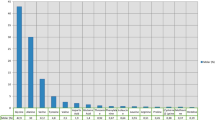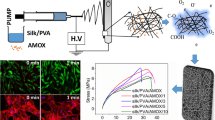Abstract
Raw silk has the potential to be a flexible, osteoconductive material because it forms bone-like apatite on its surface in acellular simulated body fluid with ion concentrations nearly 1.5 times greater than that of human plasma (1.5SBF). It has been reported that silk—which has many similarities to raw silk—develops antibacterial properties when heated in inert gas, which may be advantageous in preventing bacterial infection. Hence, raw silk heated in inert gas may be a flexible, osteoconductive material with antibacterial activity. Thus, we examined the effect of the heat treatment of raw silk fabric on its apatite-forming ability in 1.5SBF and on the growth of Escherichia coli. Raw silk fabric was heated in argon gas at several temperatures, to a maximum of 500 °C. The results of soaking tests in 1.5SBF indicate that the apatite-forming ability of raw silk decreases with increasing temperature. This may be because favourable structures for apatite formation, such as carboxyl groups, are thermally decomposed. The results of bacterial tests indicate that raw silk fabrics heated to 300 °C or 500 °C exhibit reduced bacterial growth compared to those that were not heated or were heated only to 100 °C. This might be because hydrophobic surfaces inhibit bacterial adhesion, or because the thermal decomposition of sericin—a component of raw silk—leads to a lack of available nutrients for the bacteria. Although this study did not demonstrate the expected material properties needed for clinical applications, this research contributes to a better understanding of silk biomaterials.









Similar content being viewed by others
References
Hench LL. Bioceramics. J Am Ceram Soc. 1998. https://doi.org/10.1111/j.1151-2916.1998.tb02540.x.
Hench LL, Andersson Ö. Bioactive glasses. In: Hench LL, Wilson J, editors. An introduction to bioceramics. Singapore: World scientific; 1993. pp. 41–62.
Kokubo T. A/W glass-ceramic: processing and properties. In: Hench LL, Wilson J, editors. An introduction to bioceramics. Singapore: World scientific; 1993. pp. 75–88.
Yamamuro T. A/W glass-ceramic: clinical applications. In: Hench LL, Wilson J, editors. An introduction to bioceramics. Singapore: World scientific; 1993. pp. 89–103.
LeGeros RZ. Dense hydroxyapatite. In: Hench LL, Wilson J, editors. An introduction to bioceramics. Singapore: World scientific; 1993. pp. 139–80.
Shors EC, Holmes RE. Porous hydroxyapatite. In: Hench LL, Wilson J, editors. An introduction to bioceramics. Singapore: World scientific; 1993. pp. 181–98.
Kim HM, Miyaji F, Kokubo T, Nakamura T. Preparation of bioactive Ti and its alloys via simple chemical surface treatment. J Biomed Mater Res. 1996. https://doi.org/10.1002/(SICI)1097-4636(199611)32:3<409::AID-JBM14>3.0.CO;2-B.
Kawanabe K, Ise K, Goto K, Akiyama H, Nakamura T, Kaneuji A, et al. A new cementless total hip arthroplasty with bioactive titanium porous-coating by alkaline and heat treatment: Average 4.8-year results. J Biomed Mater Res B: Appl Biomater. 2009. https://doi.org/10.1002/jbm.b.31309.
Oyane A, Kawashita M, Nakanishi K, Kokubo T, Minoda M, Miyamoto T, et al. Bonelike apatite formation on ethylene-vinyl alcohol copolymer modified with silane coupling agent and calcium silicate solutions. Biomaterials. 2003. https://doi.org/10.1016/S0142-9612(02)00581-1.
Kokubo T, Hanakawa M, Kawashita M, Minoda M, Beppu T, Miyamoto T, et al. Apatite formation on non-woven fabric of carboxymethylated chitin in SBF. Biomaterials. 2004. https://doi.org/10.1016/j.biomaterials.2003.11.007.
Rajkhowa R, Gupta VB, Kothari VK. Tensile stress-strain and recovery behavior of Indian silk fibers and their structural dependence. J Appl Polym Sci. 2000. https://doi.org/10.1002/1097-4628(20000912)77:11<2418::AID-APP10>3.0.CO;2-Q.
Santin M, Motta A, Freddi G, Vannas MF. In vitro evaluation of the inflammatory potential of the silk fibroin. J Biomed Mater Res A. 1999. https://doi.org/10.1002/(SICI)1097-4636(19990905)46:3<382::AID-JBM11>3.0.CO;2-R.
Kundu B, Rajkhowa R, Kundu SC, Wang X. Silk fibroin biomaterials for tissue regenerations. Adv Drug Deliv Rev. 2013. https://doi.org/10.1016/j.addr.2012.09.043.
Takeuchi A, Ohtsuki C, Miyazaki T, Tanaka H, Yamazaki M, Tanihara M. Deposition of bone-like apatite on silk fiber in a solution that mimics extracellular fluid. J Biomed Mater Res A. 2003. https://doi.org/10.1002/jbm.a.10456.
Tanahashi M, Matsuda T. Surface functional group dependence on apatite formation on self-assembled monolayers in a simulated body fluid. J Biomed Mater Res. 1997. https://doi.org/10.1002/(SICI)1097-4636(19970305)34:3<305::AID-JBM5>3.0.CO;2-O.
Sashina ES, Golubikhin AY, Susanin AI. Prospects for producing new biomaterials based on fibroin. Fibre Chem. 2015. https://doi.org/10.1007/s10692-016-9675-8.
Komatsu K. Chemistry and structure of silk. JARQ. 1979;13(1):64–72.
Shirai J, Miyashita M, Sakagami M, Nakajima K, Takabayashi C, Machii H. Anti-viral effect evidenced from carbon silk made from natural silk. J Jpn Vet Med Assoc. 2008. https://doi.org/10.12935/jvma1951.61.48 (in Japanese).
Fukuyama K. Characterization of water repellency. J Surf Finish Soc Jpn. 2009. https://doi.org/10.4139/sfj.60.21 (in Japanese).
Chigama H, Kanetaka H, Furuya M, Yokota K, Kawashita M. Evaluation of apatite-forming ability and antibacterial activity of raw silk fabrics doped with metal ions. Mater Trans. 2019. https://doi.org/10.2320/matertrans.Y-M2019802.
Miyazawa T, Blout ER. The infrared spectra of polypeptides in various conformations: Amide I and II bands. J Am Chem Soc. 1961. https://doi.org/10.1021/ja01464a042.
Ki CS, Kim JW, Oh HJ, Lee KH, Park YH. The effect of residual silk sericin on the structure and mechanical property of regenerated silk filament. Int J Biol Macromol. 2007. https://doi.org/10.1016/j.ijbiomac.2007.05.005.
Tuinstra F, Koenig JL. Raman spectrum of graphite. J Chem Phys. 1970. https://doi.org/10.1063/1.1674108.
Law KY. Definitions for hydrophilicity, hydrophobicity, and superhydrophobicity: getting the basics right. J Phys Chem Lett. 2014. https://doi.org/10.1021/jz402762h.
Nishikawa G, Kawahara Y, Shioya M, Kimura T. Carbonization behavior of silk. Sen’i Gakkaishi. 2004. https://doi.org/10.2115/fiber.60.105 (in Japanese).
Taherian F, Marcon V, Vegt van der NFA, Leroy F. What is the contact angle of water on graphene? Langmuir. 2013. https://doi.org/10.1021/la304645w.
Zobell CE. The effect of solid surfaces upon bacterial activity. J Bacteriol. 1943;46:19–56.
An YH, Friedman RJ. Concise review of mechanisms of bacterial adhesion. J Biomed Mater Res. 1998. https://doi.org/10.1002/(SICI)1097-4636(199823)43:3<338::AID-JBM16>3.0.CO;2-B.
van Loosdrecht MC, Lyklema J, Norde W, Schraa G, Zehnder AJ. The role of bacterial cell wall hydrophobicity in adhesion. Appl Environ Microbiol. 1987;53(8):1893–7.
Acknowledgements
This research was partially supported by a research grant from the Division for Interdisciplinary Advanced Research and Education of Tohoku University.
Funding
This research was partially supported by a research grant from the Division for Interdisciplinary Advanced Research and Education of Tohoku University.
Author information
Authors and Affiliations
Contributions
HC made substantial contributions to the conception of the work, the acquisition, analysis, interpretation of data, and writing the paper. TY revised it critically for important intellectual content. MF, KY and HK made contributions to the conception of the antibacterial test and the interpretation of the data. MK made contributions to the conception of the work, interpretation of data, and revising it critically for important intellectual content. All authors approved the final paper and agree to be accountable for all aspects of the work in ensuring that questions related to the accuracy or integrity of any part of the work are appropriately investigated and resolved.
Corresponding author
Ethics declarations
Conflict of interest
The authors declare that they have no conflict of interest.
Additional information
Publisher’s note Springer Nature remains neutral with regard to jurisdictional claims in published maps and institutional affiliations.
Rights and permissions
About this article
Cite this article
Chigama, H., Yokoi, T., Furuya, M. et al. Apatite formation and bacterial growth on raw silk fabric heated in argon gas. J Mater Sci: Mater Med 31, 49 (2020). https://doi.org/10.1007/s10856-020-06388-4
Received:
Accepted:
Published:
DOI: https://doi.org/10.1007/s10856-020-06388-4




